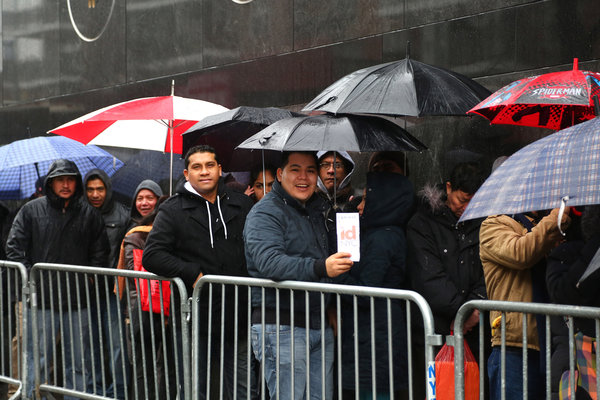Follow us on Twitter: @GoAfricaNetwork
The applicants clustered on Kissena Boulevard, clutching documents from around the world, trading familiar stories with strangers in a driving rain outside the Queens Library in Flushing. There were the police encounters, the school visits, the fraught hospital trips — all negotiated without the bureaucratic lubricant of local identification.
“We feel naked,” said Mauricio Peña, 34, who is originally from Honduras. “We feel like we don’t exist.”
At his side, a peer, who immigrated from Malaysia 17 years ago, nodded beneath his umbrella.
Such was the scene at enrollment sites across New York City on Monday, with crowds gathering by the hundreds as the de Blasio administration introduced the country’s largest municipal identification program.
The card is intended to help immigrants, undocumented or otherwise; homeless people; and others who struggle to navigate city services and institutions. Officials have also sought to entice New Yorkers with a package of benefits for those who enroll this year: prescription drug discounts, free memberships for a year to zoos, museums and other city institutions, and library access, among other perks.

There were some kinks on Monday. At the library in Flushing, where Mayor Bill de Blasio was to announce the start of the program, residents arrived in droves in the early morning, eager to apply. They were told to return in the afternoon, after the mayor’s event.
Few were discouraged. Around 2 p.m., the line snaked several hundred feet from the library doors. The crowd had heard about the card in Spanish and Korean newspapers, attendees said, or through friends. Some prospective applicants carried moldering certificates, arcane tax forms and identification from Mexico or El Salvador.
Several wore emblems of their city — a Yankees hat, a Giants coat — reinforcing their residency in case there was any doubt.
Lorena Cano, 36, who immigrated from El Salvador in 2004, waited with her two children, ages 6 and 3. She wanted a card, she said, because “it’s important, if something happens, that the country knows who I am.”
She said she also planned to take advantage of the library access for her children.
Roselda Ventura, an enrollment specialist for the program, said the Brooklyn Public Library at Grand Army Plaza was likewise inundated.
“When I first arrived, there were people already waiting for the doors to open,” Ms. Ventura said, adding that the pace of arrivals showed no signs of slowing by midafternoon.

Some managed to avoid the lines. Esther Sanchez, a mother of three from Mexico, was invited to speak beside the mayor at his news conference.
“This ID card is the key to having a more fulfilling life,” she said in Spanish, tearing up at times. (Melissa Mark-Viverito, the City Council speaker, translated for the crowd.)
As they finished, Mr. de Blasio was waiting with a surprise: Ms. Sanchez’s card was ready. He grinned and, like a municipal Oprah bearing gifts, handed it over.
Mr. de Blasio also sought to dispel concerns that undocumented immigrants might have about seeking a card.
“No one will be asked their immigration status in applying to the library for an ID,” he said, “because it’s not pertinent. If you’re a New Yorker, that’s all we care about.”
Though cities like New Haven and San Francisco have adopted similar programs, Mr. de Blasio noted that New York is unique for its dearth of drivers. About half of residents age 16 and older do not have a driver’s license, the mayor said.
Mr. Peña, who now lives in Long Island City, Queens, suggested that a city ID was all a New Yorker needed.
“We know it’s only for the city,” he said. “But it’s a big city.”

